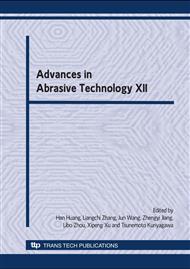p.613
p.618
p.624
p.630
p.635
p.641
p.645
p.651
p.657
A Preliminary Study of Variable Strength Activation of Coolant for Precision Machining
Abstract:
A new active cooling method is proposed for increased cooling effectiveness of coolant in grinding. It is based on variable strength activation of coolant together with active cooling to allow better machining heat transfer through mist evaporation. Multiple actuators are used through superposition and focusing. A device of variable strength coolant activation has been developed. Preliminary experimental tests were conducted to test the feasibility of the proposed cooling method. It is found that, using the proposed variable strength activation, an improvement of 87.6% in Ra value and 71.9% in Rq value were obtained when compared with the existing activated and cooled coolant cooling method.
Info:
Periodical:
Pages:
635-640
Citation:
Online since:
June 2009
Price:
Сopyright:
© 2009 Trans Tech Publications Ltd. All Rights Reserved
Share:
Citation:


